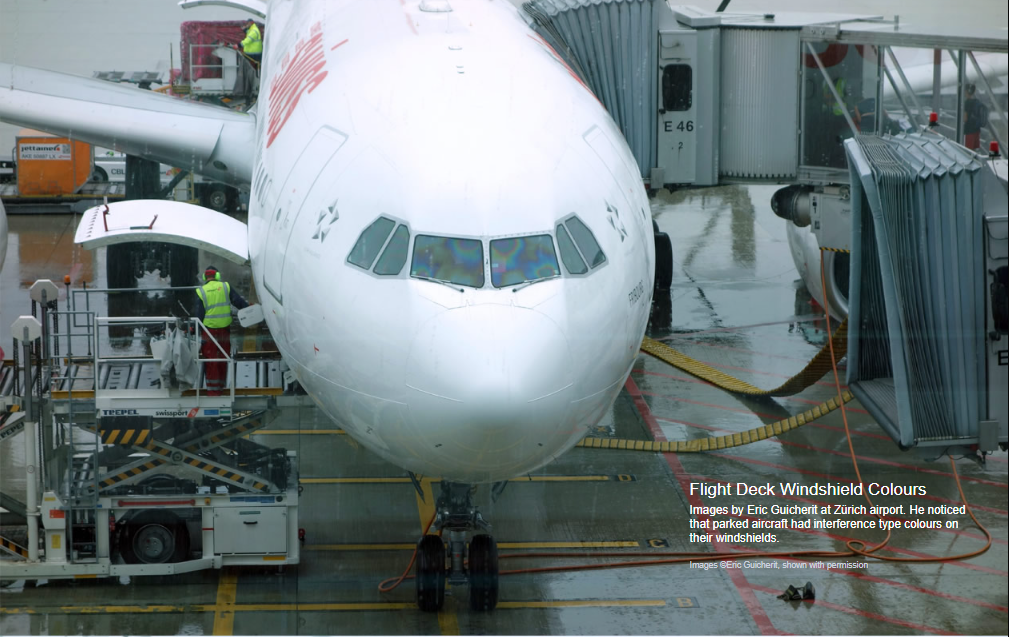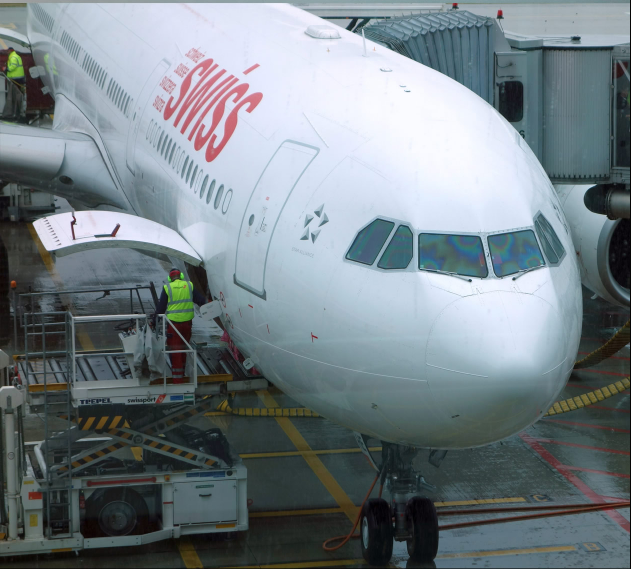Flight Deck Windshield Colours - OPOD
Flight Deck Windshield Colours - Exploring the Phenomenon
Flight deck windshields are a crucial component of aircraft, designed to withstand extreme conditions and ensure the safety of pilots and passengers. While parked aircraft may appear to have colorful patterns on their windshields, these patterns are not just for aesthetic purposes. They are the result of various optical phenomena that occur within the layers of the windshield.
The Complexity of Flight Deck Windshields
Flight deck windshields are subjected to a wide range of challenges. They must endure extreme temperature differentials, going from scorching heat to freezing cold within a short span of time. Additionally, they must withstand the pressure differentials caused by changes in altitude and the force of 500mph winds. Furthermore, flight deck windshields need to be resilient against bird and hail strikes. The failure of these windshields could lead to catastrophic consequences, so their design is of utmost importance.
Layers of Protection
To ensure the structural integrity of flight deck windshields, they are constructed using multiple layers. These layers typically include:
- Non-structural glass or acrylic: This outer layer provides protection against external elements such as rain, dust, and debris.
- Thick load-bearing glass or acrylic layers: These layers provide strength and support to withstand the forces experienced during flight.
- Inter-layers of plastics: These plastic layers help to absorb impact energy and prevent the windshield from shattering.
- Heating layer: A thin conducting film or grid is incorporated into the windshield to prevent ice formation during flight.
The combination of these layers results in a laminated structure similar to that of a car windshield, designed to crack in a controlled and safe manner.
Unveiling the Colors
The vibrant colors observed on flight deck windshields are a result of two optical phenomena: birefringence and thin film interference.
Birefringence: Anisotropic Wonder
Flight deck windshields are made of laminated toughened glass, which exhibits anisotropic properties. This anisotropy causes the glass to be birefringent, meaning that light passing through it splits into two rays with different polarizations and refractive indices.
As these rays traverse the glass, they follow slightly different optical paths. When they emerge from the glass, their wave crests can either be in phase, resulting in bright colors, or out of phase, resulting in diminished or no light. The specific colors observed depend on the wavelength (color) and viewing angle. The irregular distribution of colors is a consequence of the anisotropy induced during the manufacturing process.
Thin Film Interference: A Play of Reflections
Another contributor to the colorful patterns on flight deck windshields is thin film interference. Within the windshield, there are thin layers of plastic that can reflect light. When light enters these layers, it reflects multiple times, resulting in multiple emerging rays.
The different path lengths traveled by these rays can cause their wave crests to be in-phase, out of phase, or in some intermediate state. Similar to birefringence, the observed colors depend on the viewing angle and color wavelength. However, the colors produced by thin film interference are generally weaker compared to those generated by birefringence.
Beyond the Flight Deck
The optical phenomena observed on flight deck windshields are not exclusive to aviation. Similar effects can be seen in other contexts:
- Passenger windows: The windows throughout the cabin of an aircraft also exhibit birefringence, potentially resulting in bands of false color in photographs.
- Car windshields: Car windshields, like flight deck windshields, are made of toughened laminated glass. Consequently, they may also display similar but less pronounced patterns of color.
Exploring the Colors
To fully appreciate the phenomenon of flight deck windshield colors, one can use plane polarized light to illuminate the material and view or photograph it through a second polarizer. This method enhances the visibility of the colors generated by birefringence. However, in many cases, the colors can still be observed without deliberate polarization due to the inherent properties of the multi-layered windows.
In conclusion, the vibrant colors observed on flight deck windshields are a fascinating result of the complex structure and optical properties of these essential aircraft components. Understanding the underlying phenomena of birefringence and thin film interference allows us to appreciate the intricate interplay of light within these layered structures. So, the next time you find yourself gazing out of an airplane window, take a moment to marvel at the hidden beauty of flight deck windshield colors.

Flight Deck Windshield Colours
Images by Eric Guicherit at Zürich airport. He noticed that parked aircraft had interference type colours on their windshields.
Images ©Eric Guicherit, shown with permission

Flight deck windshields have much to withstand.
There are extremes of temperature, +30 to -50C within 20 minutes or so after a hot weather take-off. Pressure differentials of a significant part of an atmosphere. 500mph winds. Bird and hail strikes.
They must not fail. Or, at minimum, they must fail without loss of pressure or structural integrity.
Their designs vary, but essentially they have (1) non structural glass or acrylic, (2) thick load bearing glass or acrylic layers, (3) inter-layers of plastics and (4) a heating layer of a thin conducting film or grid. A typical window will have 5-6 or more layers. The glass is laminated like that of a car windscreen, designed to crack in a controlled and safe manner.
The colours are generated by the laminated glass (birefringence) and possibly also by thin plastic layers (thin film interference). A thin film of water from the rain might contribute but that is unlikely given the symmetry of the colour patterns.

Birefringence
Laminated toughened glass is anisotropic and this causes it to be birefringent. Light entering it splits into two distinct rays which are polarised and refracted differently.
The two rays have slightly different optical path lengths as they traverse the glass. On emerging, their wave crests can be in phase and combine to give a bright colour. They could also be out of phase giving less or no light. The phase condition depends on the wavelength (colour) and the viewing angle. We see coloured patches!
The colours are irregular because the anisotropy is generated as the glass is heated and cooled to laminate and toughen it. The mirror symmetry of the colours on the two windshields speaks volumes that they are the result of anisotropy and strains deliberately introduced during manufacture.
Birefringence is best seen by illuminating the material with plane polarized light and then viewing or photographing it through a second polariser. The colours can often be seen without deliberate polarization. The multi-layered windows act in themselves as partial polarisers.
Passenger windows are also birefringent and can generate bands of false colour especially on photographs.
Car windscreens have toughened laminated glass – they show similar (but weaker) colour patterns.
Thin film interference
Rays reflect inside a thin film of plastic. The two (or more) emerging rays have travelled different path lengths and their wave crests might be in-phase or out of phase or in some in between condition.
The in-phase condition depends (like birefringence) on viewing angle and colour.
We see patches of colour but in general they are weaker than those from birefringence.
Soap film colours are from thin film interference.

Note: this article has been automatically converted from the old site and may not appear as intended. You can find the original article here.
Reference Atmospheric Optics
If you use any of the definitions, information, or data presented on Atmospheric Optics, please copy the link or reference below to properly credit us as the reference source. Thank you!
-
<a href="https://atoptics.co.uk/blog/flight-deck-windshield-colours-opod/">Flight Deck Windshield Colours - OPOD</a>
-
"Flight Deck Windshield Colours - OPOD". Atmospheric Optics. Accessed on December 22, 2024. https://atoptics.co.uk/blog/flight-deck-windshield-colours-opod/.
-
"Flight Deck Windshield Colours - OPOD". Atmospheric Optics, https://atoptics.co.uk/blog/flight-deck-windshield-colours-opod/. Accessed 22 December, 2024
-
Flight Deck Windshield Colours - OPOD. Atmospheric Optics. Retrieved from https://atoptics.co.uk/blog/flight-deck-windshield-colours-opod/.